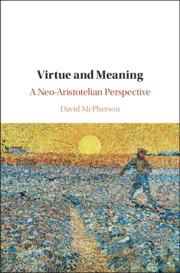Book contents
- Virtue and Meaning
- Virtue and Meaning
- Copyright page
- Dedication
- Contents
- Acknowledgments
- Introduction: Toward Re-Enchantment
- Chapter 1 The Human Form of Life
- Chapter 2 Virtue, Happiness, and Meaning
- Chapter 3 Other-Regarding Concern
- Chapter 4 Cosmic Outlooks
- Chapter 5 Homo Religiosus
- Conclusion
- References
- Index
Chapter 4 - Cosmic Outlooks
Published online by Cambridge University Press: 09 January 2020
- Virtue and Meaning
- Virtue and Meaning
- Copyright page
- Dedication
- Contents
- Acknowledgments
- Introduction: Toward Re-Enchantment
- Chapter 1 The Human Form of Life
- Chapter 2 Virtue, Happiness, and Meaning
- Chapter 3 Other-Regarding Concern
- Chapter 4 Cosmic Outlooks
- Chapter 5 Homo Religiosus
- Conclusion
- References
- Index
Summary
I make the case that neo-Aristotelian virtue ethicists need to address the question of the meaning of life (i.e., the question of how our lives fit into the grand scheme of things and whether there is a cosmic or ultimate source of meaning to which we must align our lives). I examine Bernard Williams’ forceful challenge that evolutionary science has done away with the sort of teleological worldview that is needed in order to make sense of an Aristotelian ethical perspective. I consider Hursthouse’s response to Williams’ challenge and argue that it is not sufficient. I also argue against McDowell’s quietism according to which we should remain content with the strong evaluative meanings that arise for us within a particular acquired ethical outlook (e.g., our sense of the noble) and not seek to provide any ontological grounding or justification for them beyond appealing to our second nature. I contend that what we need is in fact a teleological worldview. Against Williams, I argue that there is no necessary incompatibility between evolutionary science and a teleological worldview, and indeed there is some good reason to affirm such a worldview.
Keywords
- Type
- Chapter
- Information
- Virtue and MeaningA Neo-Aristotelian Perspective, pp. 115 - 149Publisher: Cambridge University PressPrint publication year: 2020

